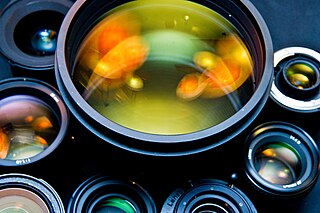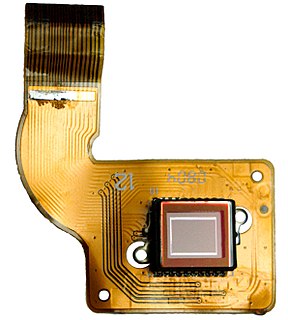
In optics, chromatic aberration is a failure of a lens to focus all colors to the same point. It is caused by dispersion: the refractive index of the lens elements varies with the wavelength of light. The refractive index of most transparent materials decreases with increasing wavelength. Since the focal length of a lens depends on the refractive index, this variation in refractive index affects focusing. Chromatic aberration manifests itself as "fringes" of color along boundaries that separate dark and bright parts of the image.

The optical microscope, often referred to as the light microscope, is a type of microscope that commonly uses visible light and a system of lenses to magnify images of small objects. Optical microscopes are the oldest design of microscope and were possibly invented in their present compound form in the 17th century. Basic optical microscopes can be very simple, although many complex designs aim to improve resolution and sample contrast. Often used in the classroom and at home unlike the electron microscope which is used for closer viewing.

A camera lens is an optical lens or assembly of lenses used in conjunction with a camera body and mechanism to make images of objects either on photographic film or on other media capable of storing an image chemically or electronically.
Angular resolution or spatial resolution describes the ability of any image-forming device such as an optical or radio telescope, a microscope, a camera, or an eye, to distinguish small details of an object, thereby making it a major determinant of image resolution. In physics and geosciences, the term spatial resolution refers to the precision of a measurement with respect to space.

The resolution of an optical imaging system – a microscope, telescope, or camera – can be limited by factors such as imperfections in the lenses or misalignment. However, there is a principal limit to the resolution of any optical system, due to the physics of diffraction. An optical system with resolution performance at the instrument's theoretical limit is said to be diffraction-limited.

In optical engineering, the objective is the optical element that gathers light from the object being observed and focuses the light rays to produce a real image. Objectives can be a single lens or mirror, or combinations of several optical elements. They are used in microscopes, telescopes, cameras, slide projectors, CD players and many other optical instruments. Objectives are also called object lenses, object glasses, or objective glasses.
Image resolution is the detail an image holds. The term applies to raster digital images, film images, and other types of images. Higher resolution means more image detail.

Bridge cameras are cameras that fill the niche between the single-lens reflex cameras (SLRs) and the point-and-shoot camera which are prominent in the prosumer market segment. They are often comparable in size and weight to the smallest digital SLRs (DSLR), but lack interchangeable lenses, and almost all digital bridge cameras lack an optical viewfinder system. The phrase "bridge camera" has been in use at least since the 1980s, and continues to be used with digital cameras. The term was originally used to refer to film cameras which "bridged the gap" between point-and-shoot cameras and SLRs.

An image sensor or imager is a sensor that detects and conveys information used to make an image. It does so by converting the variable attenuation of light waves into signals, small bursts of current that convey the information. The waves can be light or other electromagnetic radiation. Image sensors are used in electronic imaging devices of both analog and digital types, which include digital cameras, camera modules, medical imaging equipment, night vision equipment such as thermal imaging devices, radar, sonar, and others. As technology changes, digital imaging tends to replace analog imaging.

The optical transfer function (OTF) of an optical system such as a camera, microscope, human eye, or projector specifies how different spatial frequencies are handled by the system. It is used by optical engineers to describe how the optics project light from the object or scene onto a photographic film, detector array, retina, screen, or simply the next item in the optical transmission chain. A variant, the modulation transfer function (MTF), neglects phase effects, but is equivalent to the OTF in many situations.

An active-pixel sensor (APS) is an image sensor where each picture element ("pixel") has a photodetector and an active amplifier. There are many types of integrated circuit active pixel sensors including the complementary metal–oxide–semiconductor (CMOS) APS used most commonly in cell phone cameras, web cameras, most digital pocket cameras since 2010, in most digital single-lens reflex cameras (DSLRs) and Mirrorless interchangeable-lens cameras (MILCs). Such an image sensor is produced using CMOS technology, and has emerged as an alternative to charge-coupled device (CCD) image sensors.
Sony produces professional, consumer, and prosumer camcorders.

Note: If you came here to get a quick understanding of numbers like 1/2.3, skip ahead to table of sensor formats and sizes. For a simplified discussion of image sensors see image sensor.

A digital microscope is a variation of a traditional optical microscope that uses optics and a digital camera to output an image to a monitor, sometimes by means of software running on a computer. A digital microscope often has its own in-built LED light source, and differs from an optical microscope in that there is no provision to observe the sample directly through an eyepiece. Since the image is focused on the digital circuit, the entire system is designed for the monitor image. The optics for the human eye are omitted.

Optical sectioning is the process by which a suitably designed microscope can produce clear images of focal planes deep within a thick sample. This is used to reduce the need for thin sectioning using instruments such as the microtome. Many different techniques for optical sectioning are used and several microscopy techniques are specifically designed to improve the quality of optical sectioning.

A back-illuminated sensor, also known as backside illumination sensor, is a type of digital image sensor that uses a novel arrangement of the imaging elements to increase the amount of light captured and thereby improve low-light performance.

The Fujifilm X-Pro1 is a mirrorless interchangeable-lens digital camera announced in January 2012 and launched in March 2012. It is part of Fujifilm's X-Series of cameras. In October 2012 Fujifilm has released a very similar, yet smaller, camera named the X-E1. In January 2016 Fujifilm announced its successor the X-Pro2.

The Nikon D7100 is a 24.1-megapixel digital single-lens reflex camera model announced by Nikon in February 2013. It is a prosumer model that replaces the Nikon D7000 as Nikon's flagship DX-format camera, fitting between the company's entry-level and professional DSLR models. Nikon gives the D7100's Estimated Selling Price in the United States as US$949.95 for the body alone.
















